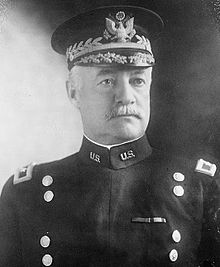Hunter Liggett
| Hunter Liggett | |
|---|---|

Liggett as a brigadier general.
|
|
| Born |
March 21, 1857 Reading, Pennsylvania |
| Died | December 30, 1935 (aged 78) San Francisco, California |
| Place of burial | San Francisco National Cemetery |
| Allegiance |
|
| Service/branch |
|
| Years of service | 1879–1921 |
| Rank |
|
| Unit |
|
| Commands held |
Philippine Department 41st Infantry Division I Corps First Army Third Army |
| Battles/wars |
Indian Wars Spanish–American War Philippine–American War World War I |
| Awards |
Distinguished Service Medal Croix de Guerre (France) Légion d'honneur (France) |
Hunter Liggett (March 21, 1857 – December 30, 1935) was a senior United States Army officer. His 42 years of service spanned the period from the Indian campaigns to trench warfare of World War I. Additionally, he identified possible invasion sites in Luzon, particularly Lingayen Gulf which was used during World War II in 1941 by the Japanese and in 1945 by the Americans.
Liggett was born March 21, 1857 in Reading, Pennsylvania. After his graduation from West Point as a second lieutenant in 1879, he was assigned to the 5th Infantry, where he served in both the Montana and Dakota territories, as well as Texas and Florida, during which time he reached the rank of Captain.
His field service in the American west, the Spanish–American War, and the Philippine–American War honed his skills as a military leader.
In 1907, he assumed command of a battalion of the 13th Infantry Regiment at Fort Leavenworth, Kansas. From 1909 to 1914, he served as student, faculty member, and president at the Army War College, receiving a promotion to brigadier general in February 1913.
Liggett's services in the Philippines included setting up a staff ride in 1914 to study possible invasion sites on Luzon. He was assisted in this by his aide de camp, Captain George Marshall. The staff ride established that the most likely invasion route would be through the Lingayen Gulf and that this would be all but unstoppable unless the US dramatically increased its Army and Navy forces in the Philippines. In 1941, the Japanese invaded through the Lingayen Gulf, as the US did in turn in 1945.
...
Wikipedia
